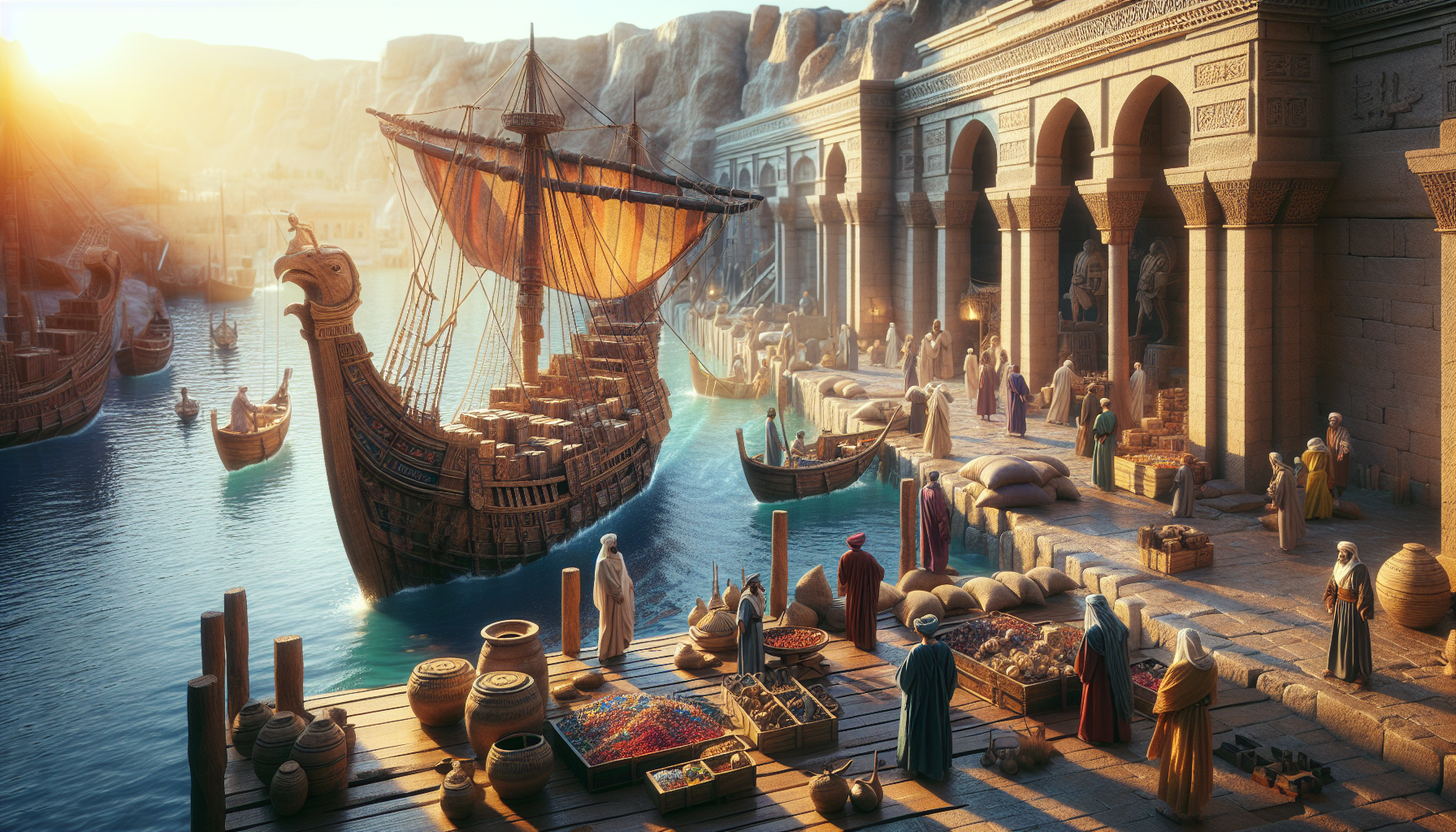In a world where GPS systems and digital maps guide our every move, it’s easy to forget that the art of navigation once relied on the stars, the winds, and the whispers of the sea. 🌍 Before the age of technology, ancient civilizations mastered the secrets of navigation, paving the way for the interconnected global commerce we witness today. From the Silk Road’s vast network of trade routes to the maritime prowess of the Polynesians, these ancient pathways were the lifeblood of empires, shaping economies, cultures, and even the course of history. But what were these routes really like, and how did they impact the global stage? Join us on a fascinating journey as we unlock the secrets of ancient navigation and explore the profound impact of these trade routes on global commerce.
The story begins thousands of years ago when daring merchants and explorers set out into the unknown, driven by curiosity, ambition, and the promise of exotic goods. These trade routes were more than just pathways for commodities; they were conduits for ideas, technologies, and cultural exchanges that shaped the very fabric of human civilization. The Silk Road, a sprawling network that connected China to the Mediterranean, was instrumental in the exchange of silk, spices, and precious metals, but it also facilitated the spread of philosophies, art, and even religions. Meanwhile, the maritime trade routes of the Indian Ocean connected the bustling markets of Africa, the Middle East, India, and Southeast Asia, fostering an era of unprecedented economic and cultural dynamism.
As we delve into the intricacies of these ancient trade routes, we will uncover the innovative navigation techniques employed by early explorers. The Phoenicians, renowned for their seafaring skills, developed advanced methods of celestial navigation, allowing them to venture far beyond the sight of land. Similarly, the Polynesians, with their deep understanding of the ocean’s rhythms and patterns, navigated thousands of miles of open water to colonize the vast Pacific islands. These navigational feats were not only remarkable for their time but laid the groundwork for future explorations that would connect the world in ways previously unimaginable.
Moreover, we will examine the impact of these ancient trade routes on the economies of their time. By facilitating the exchange of goods and ideas, these routes acted as the arteries of early globalization. They enabled the rise of powerful trading cities, fostered economic interdependence, and allowed for the accumulation of wealth and resources on an unprecedented scale. The demand for luxury goods like silk, spices, and precious stones spurred advancements in transportation and logistics, leading to the development of more efficient ships and caravans. This, in turn, spurred competition among emerging empires, each vying for control over these lucrative routes.
Finally, we will consider the enduring legacy of these ancient trade routes in today’s global commerce. The principles of interconnectedness and cultural exchange that defined these pathways continue to resonate in the modern world. The routes may have evolved, and the goods may have changed, but the fundamental concept of a global marketplace remains as relevant as ever. As we navigate the complexities of contemporary global trade, understanding the historical foundations of these ancient routes provides invaluable insights into the challenges and opportunities that lie ahead. 🌏
By journey’s end, you will have gained a deeper appreciation for the ancient navigators who dared to explore the unknown and the profound ways in which their legacy continues to shape our world. So, fasten your seatbelts, adjust your compass, and get ready to embark on an adventure through time and space as we unlock the secrets of navigation and explore the ancient trade routes that laid the groundwork for today’s global commerce. 🚀
The Dawn of Navigation: Ancient Beginnings
Navigation, an art and science that has evolved dramatically over millennia, finds its roots deeply embedded in ancient civilizations. The initial strides in navigation were made by the Mesopotamians and the Egyptians, who, as early as 4,000 BC, began to traverse the Nile and the Tigris-Euphrates river systems. These early navigators relied heavily on the stars and rudimentary tools to chart their courses, setting the stage for more sophisticated methods.
The Greeks and the Phoenicians were instrumental in pushing the boundaries of navigation further. The Phoenicians, known for their maritime prowess, established extensive trade networks across the Mediterranean. Their expertise in shipbuilding and navigation enabled them to dominate trade routes and spread their influence across North Africa and into the Iberian Peninsula. Meanwhile, the Greeks made significant contributions by developing early maps and studying the stars, with notable figures such as Ptolemy advancing the field of cartography and astronomical navigation.
As these ancient civilizations ventured further into the unknown, they laid the foundation for what would eventually become a global system of trade and exploration. The compendium of knowledge they amassed, from the identification of celestial bodies to the understanding of wind patterns and ocean currents, was critical. Their legacy paved the way for the Age of Exploration, where navigation would become the lifeline of empires and the backbone of global commerce.
Tools of the Trade
To appreciate the sophistication of ancient navigation, one must delve into the tools and techniques that were developed. The astrolabe, for instance, was a pivotal invention attributed to the Greeks, allowing navigators to determine latitude by measuring the angle of the sun or stars above the horizon. This instrument remained in use for centuries, evolving over time to improve accuracy and ease of use.
Another essential tool was the quadrant, which enabled mariners to measure the altitude of celestial bodies, further refining their ability to pinpoint their location at sea. These devices, combined with a deep understanding of the night sky, empowered ancient sailors to embark on increasingly ambitious voyages.
In addition to these tools, oral traditions and navigational lore played a crucial role. Sailors shared knowledge of wind patterns, ocean currents, and weather phenomena, forming an invaluable repository of information passed down through generations. This blend of science, observation, and storytelling underpinned the development of reliable navigational techniques that would be essential for the expansion of trade routes.
The Rise of Trade Routes
The establishment of trade routes was a turning point in the history of navigation. These routes facilitated the exchange of goods, ideas, and cultures, shaping the course of history. Among the most significant were the Silk Road and the Spice Routes, both of which transformed the economies and societies they connected.
The Silk Road, a network of overland routes connecting the East and West, was instrumental in the exchange of silk, spices, and other valuable commodities. This trade network, spanning thousands of miles, allowed for the flow of goods and ideas, fostering cross-cultural exchanges that enriched civilizations on either side.
Similarly, the Spice Routes, which traversed the Indian Ocean, linked Southeast Asia, the Middle East, and Europe. The demand for spices such as cinnamon, nutmeg, and cloves drove the development of maritime trade networks, spurring advancements in shipbuilding and navigation. These routes were critical to the economies of the regions they connected, facilitating the rise of powerful trading empires and influencing culinary traditions around the world.
Economic Impact of Ancient Trade Routes
The economic impact of ancient trade routes cannot be overstated. They were the arteries of commerce, enabling the flow of goods across vast distances and linking disparate economies. The wealth generated from these routes fueled the growth of cities, the development of infrastructure, and the rise of powerful empires.
Trade routes also played a vital role in the dissemination of technology and knowledge. Innovations in agriculture, metallurgy, and craftsmanship spread along these routes, transforming societies and contributing to economic prosperity. The exchange of ideas and technologies facilitated by trade routes led to advancements in various fields, including medicine, astronomy, and engineering.
The interconnectedness fostered by trade routes laid the groundwork for a global economy, setting the stage for the modern era of international trade. As the demand for exotic goods grew, so too did the complexity of trade networks, driving further advancements in navigation and exploration.
Technological Advancements in Navigation
The evolution of navigation technology was driven by the need for precision and reliability in increasingly complex trade networks. From the development of the compass to the refinement of ship designs, each advancement played a crucial role in expanding the boundaries of exploration.
The magnetic compass, first used by the Chinese during the Han Dynasty, revolutionized navigation by providing a reliable means of determining direction. This innovation spread to the Islamic world and eventually to Europe, where it became an indispensable tool for sailors navigating the high seas.
Shipbuilding also saw significant advancements, with the development of the caravel and the carrack during the Age of Exploration. These ships were designed for long voyages, featuring innovations such as lateen sails and improved hull designs that enhanced their speed and maneuverability. The ability to undertake transoceanic voyages opened new trade routes and expanded the reach of empires.
The Role of Astronomy in Navigation
Astronomy played a pivotal role in the advancement of navigation, with celestial bodies serving as guiding lights for mariners. The development of more accurate celestial charts and the refinement of techniques for measuring the position of stars allowed for greater precision in determining latitude and longitude.
Notable figures such as Johannes Kepler and Galileo Galilei made significant contributions to the understanding of celestial mechanics, providing the theoretical foundation for more accurate navigation. Their work laid the groundwork for the eventual development of the sextant, an instrument that would further revolutionize navigation by allowing for precise measurements of angles between celestial bodies and the horizon.
These advancements in astronomy and navigation were instrumental in enabling the voyages of explorers such as Christopher Columbus, Vasco da Gama, and Ferdinand Magellan, who charted new territories and opened new trade routes that reshaped the world.
The Impact on Global Commerce
The impact of ancient trade routes on global commerce is profound, with their influence still felt today. These routes were the lifelines of economic exchange, fostering the growth of cities, the rise of empires, and the spread of cultures.
The interconnectedness of trade routes facilitated the flow of goods and ideas, contributing to economic prosperity and cultural enrichment. The exchange of commodities such as silk, spices, and precious metals fueled the growth of trade networks and laid the groundwork for a global economy.
The legacy of ancient trade routes is evident in the modern world, where international trade continues to drive economic growth and connect societies across the globe. The principles of navigation and trade established by ancient civilizations continue to shape the course of commerce and exploration.
Modern Relevance of Ancient Trade Routes
Today, the influence of ancient trade routes can be seen in the ongoing globalization of markets and the interconnectedness of economies. The principles of navigation and trade developed by ancient civilizations continue to inform modern practices, with the global supply chain serving as a testament to the enduring legacy of these routes.
Efforts to revive and expand trade routes, such as China’s Belt and Road Initiative, reflect the continued importance of these pathways in shaping the global economy. By facilitating the flow of goods, capital, and ideas, these initiatives seek to build on the foundation laid by ancient trade routes, fostering economic growth and development in regions across the world.
The enduring relevance of ancient trade routes is a testament to their impact on global commerce, serving as a reminder of the power of connectivity and the importance of collaboration in an increasingly interconnected world.
Exploring Further: Resources and Videos
For those interested in delving deeper into the fascinating world of ancient navigation and trade routes, a wealth of resources is available. Documentaries, books, and online courses offer insights into the history, technology, and impact of these routes on global commerce.
- Books: Look for titles such as “The Silk Roads: A New History of the World” by Peter Frankopan, which explores the significance of trade routes in shaping history.
- Online Courses: Platforms like Coursera and edX offer courses on ancient history and navigation, providing a comprehensive understanding of the subject.
- Documentaries: Films like “Ancient Worlds” provide a visual exploration of the civilizations that pioneered trade routes and navigation techniques.
For a more interactive experience, consider watching the video below which provides an overview of the history of navigation and its impact on global commerce.
🎥 “History of Navigation” – National Geographic

Conclusion
Conclusion: Unlocking the Secrets of Navigation: Exploring Ancient Trade Routes and their Impact on Global Commerce
As we draw to a close on our exploration of ancient trade routes and their profound impact on global commerce, it becomes apparent just how pivotal these pathways were in shaping the world as we know it today. Throughout this article, we’ve delved into the fascinating tapestry of history, geography, and human ingenuity that brought about some of the most significant advances in trade and cultural exchange.
To begin with, we explored the origins of ancient trade routes, such as the Silk Road, the Trans-Saharan Trade Route, and the Maritime Spice Routes. These pathways not only facilitated the exchange of goods like silk, spices, and precious metals but also fostered a vibrant exchange of ideas, culture, and technology. The Silk Road, for example, was instrumental in connecting the East and West, allowing for the flow of knowledge, including advancements in mathematics, astronomy, and medicine, that would otherwise have been localized to specific regions.
Moving forward, we examined the navigation techniques and innovations that made these ancient trade routes possible. From the use of stars and rudimentary compasses to more sophisticated instruments like the astrolabe, ancient navigators displayed remarkable skill and bravery as they ventured into uncharted territories. These advancements laid the groundwork for the Age of Exploration, which expanded global trade networks even further.
In considering the economic implications, the article highlighted how ancient trade routes were catalysts for the development of cities and civilizations. The prosperity brought by trade led to the rise of influential cities such as Constantinople, Timbuktu, and Venice. These cities became melting pots of culture and commerce, where traders from diverse backgrounds could interact, exchange goods, and share ideas. The legacy of these trade routes is still evident in modern times, as many contemporary trade practices and global economic systems have roots tracing back to these ancient networks.
We also touched upon the sociopolitical impacts of these trade routes, including the spread of religions, languages, and cultural practices. As goods moved along these paths, so did philosophies and religious beliefs, leading to a richer and more interconnected world. For instance, Buddhism spread from India to China and beyond, thanks in part to the Silk Road, while Islam traversed the Sahara, influencing countless societies along the way.
Understanding the historical significance of these routes allows us to appreciate the complexities of modern global commerce. Today’s interconnected economies owe much to the pioneering traders and navigators of the past who ventured beyond known horizons. Their efforts laid the foundation for a global marketplace that thrives on diversity and exchange.
The exploration of ancient trade routes serves as a reminder of the human capacity for innovation and collaboration. It underscores the importance of connectivity in driving progress and prosperity. In today’s rapidly changing world, where globalization is sometimes met with skepticism, reflecting on these historical precedents can offer valuable insights. Recognizing that our ancestors successfully navigated challenges to foster global trade can inspire modern society to continue building bridges, rather than walls, in pursuit of mutual benefit.
As we conclude this journey through the annals of ancient trade and navigation, it is crucial to recognize the enduring legacy these routes have left behind. Their influence extends beyond commerce; they have shaped cultures, fostered innovation, and transformed societies. In acknowledging this legacy, we also find inspiration for future endeavors in global trade and diplomacy.
We encourage you, dear reader, to continue exploring this captivating subject. Dive deeper into the stories of those who charted these courses and consider the lessons they offer for today’s interconnected world. Engage in discussions, share your insights, and apply what you have learned to appreciate the complexities and opportunities of global commerce.
Let this exploration ignite a curiosity and appreciation for the intricate web of history that connects us all. 🌍 Together, we can celebrate the rich heritage of ancient trade routes while striving to create a future that honors their spirit of discovery and cooperation. As we look to the horizon, may we be inspired to navigate the challenges of our time with the same courage and vision that guided those who came before us.
For further exploration, consider visiting these resources:
1. The Silk Road: Connecting the Ancient World through Trade – Khan Academy
2. Trans-Saharan Trade and the Kingdom of Ghana – Britannica
3. The Spice Routes: Maritime Trade in the Indian Ocean – The Met
By continuing this dialogue, we honor the legacy of those who pioneered global trade and ensure that their contributions remain a beacon for future generations.
Toni Santos is a visual storyteller and cosmic interpreter whose work illuminates the ancient skywatchers and their prehistoric astronomy—the profound ways early humans observed and revered the heavens before written history. Through a visionary lens, Toni explores how the stars, planets, and celestial cycles shaped myth, ritual, and survival in cultures lost to time.
Rooted in a fascination with archaic observatories, stone alignments, and celestial symbolism, Toni’s creative journey reveals the deep human impulse to understand and harmonize with the cosmos. From lunar phases guiding planting seasons to the sacred paths of the Milky Way, each of his works embodies the awe and knowledge encoded in the night sky.
Combining artistic craftsmanship with archaeological insight, Toni’s pieces evoke the mystery and precision of prehistoric astronomers. His work does more than depict—it channels the timeless dance between earth and sky, bridging ancient wisdom with contemporary wonder.
As the visionary behind Vizovex, Toni shares curated visuals, essays, and symbolic studies that invite others to reconnect with the cosmic heritage written in stone and starlight. His creations are a call to look upward, to listen to the silent stories told by the stars, and to honor the first astronomers who mapped the heavens with reverence and ingenuity.
His work is a tribute to:
The celestial wisdom of prehistoric peoples
The sacred geometry of ancient observatories
The enduring bond between human culture and the cosmos
Whether you’re a stargazer, a scholar of ancient mysteries, or someone captivated by the universe’s earliest storytellers, Toni welcomes you to journey through a space where the sky is both map and myth—one constellation, one ritual, one revelation at a time.




